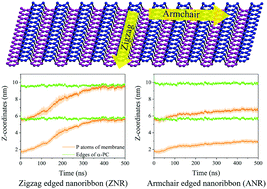Mild lipid extraction and anisotropic cell membrane penetration of α-phase phosphorene carbide nanoribbons by molecular dynamics simulation studies†
Abstract
A systematic understanding of interactions at the nano–bio interface is critical for the development of bio-functional nanomaterials and nano-agents for medical applications, which essentially require high safety, biocompatibility and therapeutic efficiency. As a new member of the two-dimensional material family, α-phase phosphorene carbide (α-PC) has attracted significant research interest in recent years. Benefitting from the unique buckled structure and its rich physical and chemical features, the future applications of α-PC in biological and medical areas are intriguing. Using molecular dynamics simulations (MDs), herein, we theoretically explore the interactions of α-PC nanoribbons with the cell lipid membrane to evaluate the potential biological toxicity to lipids. Our results clearly demonstrate that the α-PC sheet can only penetrate the membrane along its zigzag direction by attracting the lipids to the groove regions. The membrane undergoes slight structural distortion, but quickly recovers after the penetration. Only localized impacts are detected on the membrane after the penetration. In contrast, the intrusion along armchair direction is highly blocked by lipids. Free energy analysis by the umbrella sampling method revealed that the fatty acid tails of lipids prefer to bind along the groove regions of α-PC rather than across the grooves, resulting in a high anisotropic penetration behavior. The overall attraction of α-PC to lipid is weaker than graphene, and the binding lipids cannot be fully extracted from the membrane environment. The self-equilibration of the membrane is fast enough to prevent lipids from escaping, leading to the well-preserved membrane integrity. Our present findings suggest that α-PC might offer new potential as bio-agents with high membrane-penetrating efficiency and lower cytotoxicity. The unique anisotropic behaviors can be further utilized for the design and fabrication of specialized nanomaterials with the capability of efficient and template-directed molecule delivery.



 Please wait while we load your content...
Please wait while we load your content...